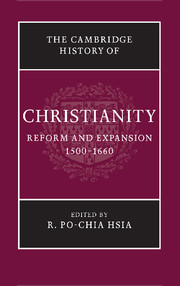Book contents
- Frontmatter
- Part I Luther and the Holy Roman Empire
- Part II The Second Reformation
- Part III Catholic Renewal
- Part IV Resolving Confessional Conflicts
- Part V Religion, Society, and Culture
- 19 The Reformation and the visual arts
- 20 Ritual in early modern Christianity
- 21 Music and religious change
- 22 Demonology, 1500–1660
- 23 Science and religion
- 24 The new clergies
- 25 Women and religious change
- Part VI Christianity and Other Faiths
- Bibliography
- Index
- References
24 - The new clergies
from Part V - Religion, Society, and Culture
Published online by Cambridge University Press: 28 March 2008
- Frontmatter
- Part I Luther and the Holy Roman Empire
- Part II The Second Reformation
- Part III Catholic Renewal
- Part IV Resolving Confessional Conflicts
- Part V Religion, Society, and Culture
- 19 The Reformation and the visual arts
- 20 Ritual in early modern Christianity
- 21 Music and religious change
- 22 Demonology, 1500–1660
- 23 Science and religion
- 24 The new clergies
- 25 Women and religious change
- Part VI Christianity and Other Faiths
- Bibliography
- Index
- References
Summary
As the title of this volume suggests, the long-prevailing division of the history of the European Reformation into ‘Reformation’ and ‘Counter-Reformation’ has been overtaken by more recent research. The older model has been replaced by that of a single reform movement, one which resulted in the formation of confessional churches on the one hand and a deferred Catholic reform movement on the other; thus, it makes more sense to talk about a ‘Catholic reform’ or ‘renewal’. At times parallel and at times interdependent, these developments are vividly illustrated by the history of confessional office-holders – both the Protestant clergy and the Catholic ‘reform clergy’. Strong arguments suggest that from the mid-seventeenth century on, there remained few significant differences, in terms of educational and/or socio-economic backgrounds, between Protestant pastors and the Catholic pastoral clergy. This effectively contradicts Max Weber’s thesis that Protestants enjoyed an educational advantage over Catholics.
Medieval traditions
Visitation reports from a number of European regions, dating back to the mid-sixteenth century and offering an insight into the educational levels of the clergy on the eve of the Reformation, record an urgent need for improvement. Much was left to be desired regarding the theological training of both the lower clergy and those theologians who, although ordained to higher orders, served merely as holders of benefices and failed to carry out their spiritual duties. Similar deficits existed concerning their pastoral abilities and preaching skills. In addition, the personal conduct of all clergy groups remained a constant bone of contention in the eyes of the congregation as well as of secular and ecclesiastical authorities. Most of these deficiencies clashed with even the medieval ideal of a priest.
- Type
- Chapter
- Information
- The Cambridge History of Christianity , pp. 444 - 464Publisher: Cambridge University PressPrint publication year: 2007
References
- 1
- Cited by



